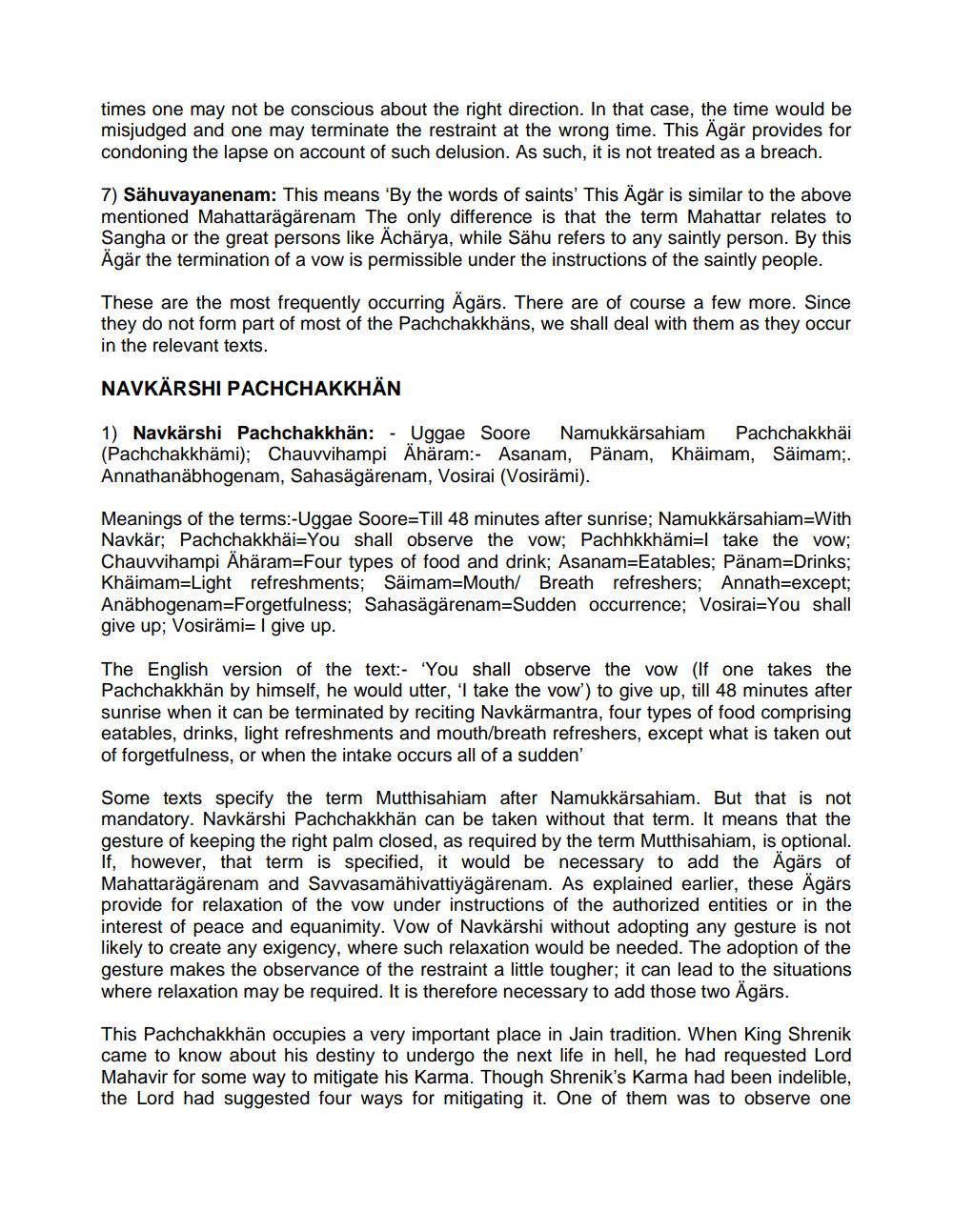________________
times one may not be conscious about the right direction. In that case, the time would be misjudged and one may terminate the restraint at the wrong time. This Agär provides for condoning the lapse on account of such delusion. As such, it is not treated as a breach.
7) Sähuvayanenam: This means 'By the words of saints' This Ägär is similar to the above mentioned Mahattarägärenam The only difference is that the term Mahattar relates to Sangha or the great persons like Acharya, while Sähu refers to any saintly person. By this Ägär the termination of a vow is permissible under the instructions of the saintly people.
These are the most frequently occurring Agärs. There are of course a few more. Since they do not form part of most of the Pachchakkhäns, we shall deal with them as they occur in the relevant texts.
NAVKÄRSHI PACHCHAKKHÂN
1) Navkärshi Pachchakkhän: - Uggae Soore Namukkärsahiam Pachchakkhäi (Pachchakkhämi); Chauvvihampi Ahäram:- Asanam, Pänam, Khaimam, Säimam;. Annathanäbhogenam, Sahasägärenam, Vosirai (Vosirämi).
Meanings of the terms:-Uggae Soore=Till 48 minutes after sunrise; Namukkärsahiam=With Navkär; Pachchakkhäi=You shall observe the vow; Pachhkkhämizi take the vow; Chauvihampi Ähäram=Four types of food and drink; Asanam=Eatables; Pänam=Drinks; Khaimam=Light refreshments; Säimam=Mouth/Breath refreshers; Annath=except; Anäbhogenam=Forgetfulness; Sahasägärenam=Sudden occurrence; Vosirai=You shall give up; Vosirämi= 1 give up.
The English version of the text:- 'You shall observe the vow (If one takes the Pachchakkhän by himself, he would utter, 'I take the vow') to give up, till 48 minutes after sunrise when it can be terminated by reciting Navkärmantra, four types of food comprising eatables, drinks, light refreshments and mouth/breath refreshers, except what is taken out of forgetfulness, or when the intake occurs all of a sudden'
Some texts specify the term Mutthisahiam after Namukkärsahiam. But that is not mandatory. Navkärshi Pachchakkhän can be taken without that term. It means that the gesture of keeping the right palm closed, as required by the term Mutthisahiam, is optional. If, however, that term is specified, it would be necessary to add the Agärs of Mahattarägärenam and Savvasamähivattivägärenam. As explained earlier, these Agärs provide for relaxation of the vow under instructions of the authorized entities or in the interest of peace and equanimity. Vow of Navkärshi without adopting any gesture is not likely to create any exigency, where such relaxation would be needed. The adoption of the gesture makes the observance of the restraint a little tougher; it can lead to the situations where relaxation may be required. It is therefore necessary to add those two Agärs.
This Pachchakkhän occupies a very important place in Jain tradition. When King Shrenik came to know about his destiny to undergo the next life in hell, he had requested Lord Mahavir for some way to mitigate his Karma. Though Shrenik's Karma had been indelible, the Lord had suggested four ways for mitigating it. One of them was to observe one
suggested mitigate his Kalengo the next hide in




